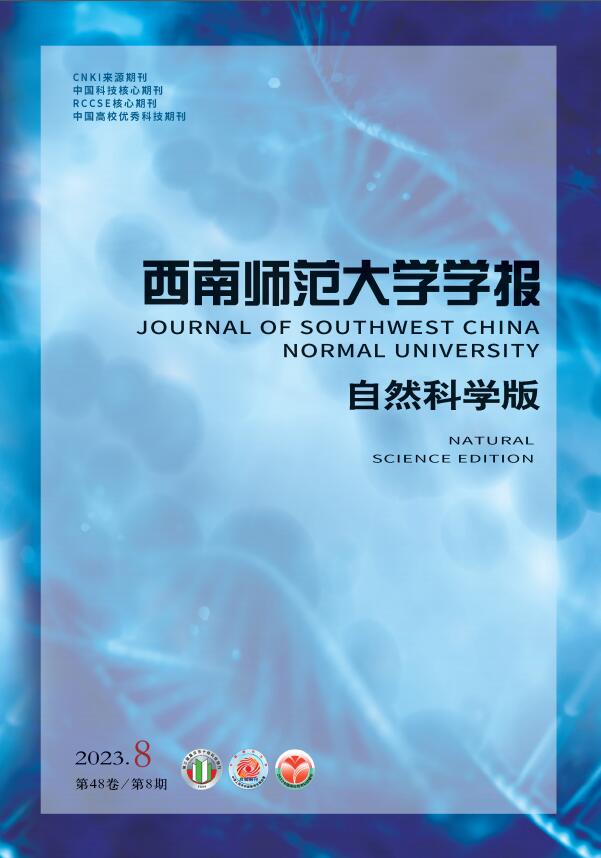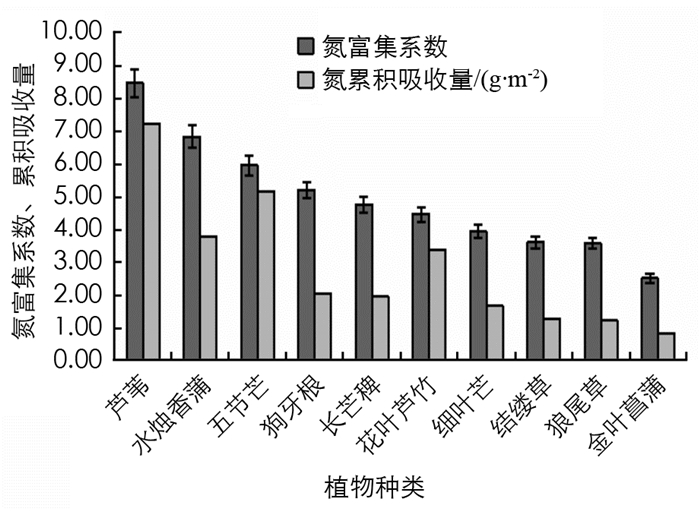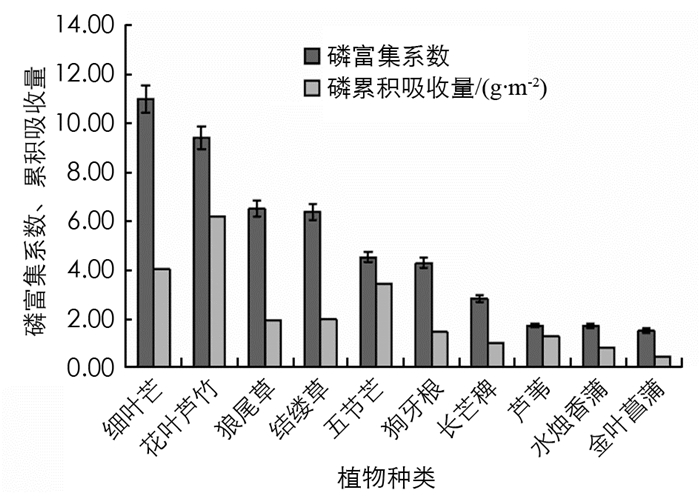-
三峡水库的“蓄清排浑”调度方式,形成了长江水位季节性涨落,使土地呈现出周期性的露出和淹没. 库区水位每年均在145~175 m之间,形成落差约30 m,长约5 425.93 m,面积约349 km2的巨大消落带[1].
库区消落带植被受到冬季水淹和夏季干旱的双重胁迫,筛选抗性强、耐冲刷、固土性强且有观赏性的植物,成为消落带生态恢复、景观提升的有效治理途径之一. 另外,三峡库区消落带区域存在严重的富营养化[2]. 消落带内源生物的季节性生长、库区工矿企业的排放、消落带土地的不合理利用,导致库区消落带区域氮磷等富营养化问题突出[3]. 针对富营养化的有效方法是利用生物措施进行修复,植被恢复可固持土壤养分,减少土壤在雨季降水冲刷作用下进入水体的营养负荷;在淹水前对植被进行刈割、回收,可进一步减少土壤-植物系统向三峡水体释放养分负荷. 针对三峡库区消落带的生态环境问题,马利民等[4]发现苏丹草、狗牙根、尼泊尔蓼等植物具有良好的耐水淹能力和覆盖率;王正等[5]通过调研,发现库区优势草本植物苍耳、水蓼的氮磷富集系数高. 目前能同时解决生态修复和景观提升的植物的相关研究还很少.
观赏草植物因其根系发达、固土性强,具有耐淹抗旱能力和良好的观赏性,不仅可以满足消落带生态恢复绿化覆盖的需求[6],还能提升城市周边市民活动区域的消落带景观,因此,可作为消落带植被恢复的优质备选植物.
本研究以消落带为基础的湿地公园进行种植实验,评价10种备选观赏草植物的环境适应性特点,并分析其对土壤氮磷的吸收特征,进一步完善对消落带植被功能的认知,为三峡库区消落带区域的景观提升和生态修复提供技术支撑.
HTML
-
实验基地位于重庆市万州区红沙碛滨水生态公园消落带研究实验区,地处北纬30°24’,东经107°55’,占地56 600 m2. 该基地具有典型的三峡库区消落带生境特点,濒临长江,坡度缓,地形平整,水位线在145~175 m之间. 气候为典型的亚热带湿润季风气候,四季分明,夏季最长;气候温热,无霜期长,年平均气温为18.2~19.8 ℃;降水丰富,年平均降水量为1 243 mm. 土壤类型为潮土,土质为砂壤土.
-
在大量文献检索和消落带走访调查的基础上,筛选10种在消落带能够旺盛生长、根系发达抗冲刷、耐旱耐淹、观赏性好的观赏草用于研究[7]. 选定物种包括:长芒稗(Echinochloa caudata)、狗牙根(Cynodon dactylon)、细叶芒(Miscanthus sinensis)、花叶芦竹(Arundo donax var. versicolor Stokes)、水烛香蒲(Typhaangustifolia L.)、金叶菖蒲(Acorus gramineus ‘Ogon’)、芦苇(Phragmites communis)、五节芒(Miscanthus floridulus)、狼尾草(Pennisetum alopecuroides)、结缕草(Zoysia japonica Steud).
-
在实验基地垂直于江岸,从长江岸边至坡上方向构建10条平行样带,样带位于145~175 m消落带区域,规格为30 m×5 m,间隔2 m. 各样带分别种植不同的观赏草物种进行自然水淹实验[7]. 植物种植通过整株移栽或撒播方法,种植前后不施肥,自然生长. 8月底145 m水位线水淹前种植,第2年露出后进行一次补栽或撒播. 种植后连续观察3年,根据其成苗高度、植被覆盖度、适生水位来判断观赏草在消落带的适生性及适生区域.
-
种植3年后于生长旺期6-7月进行养分测定,每个种植带设置5个植物采样点,每个采样点随机取3个完整植株,洗净泥土,按植物种类分别装入尼龙网袋,带回实验室烘干粉碎过筛进行植物全氮(TN)和全磷(TP)质量分数测定[5]. 用凯氏定氮法测定TN质量分数;用钼蓝比色法测定TP质量分数.
-
植物富集系数可以用植物体内某元素的质量分数与对应土壤的相应元素质量分数的比值来表示,计算公式为
式中,E为植物对土壤养分富集系数,Pi为植物的i养分(即氮磷,下同)质量分数(mg/g),Si为植物对应实验地土壤的i养分质量分数(mg/g)[7]. 实验地土壤的氮质量分数为0.85 mg/g;磷质量分数为0.74 mg/g.
植物养分总吸收量(PA),计算公式为
式中,PA为植物养分总吸收量(g/m2),PC为植物体内氮磷质量分数(mg/g),PB为植物地上生物量(g/m2).
采用Excel 2010进行数据的录入与整理,运用SPSS 26.0软件进行统计分析;不同植物TP,TN,生物量近似服从正态分布,采用单因素方差分析方法对数据进行显著性检验,比较不同植物TP,TN,生物量的种间差异,以p<0.05为差异有统计学意义.
1.1. 研究区概况
1.2. 实验材料
1.3. 实验设计
1.3.1. 适生实验
1.3.2. 养分测定
1.4. 数据处理
-
实验区每年经历周期性的自然水淹,其中145~165 m水位线内,水淹期1-5月、9-12月,成陆期6-8月,约3个月;165~175 m水位线内,水淹期为10月至次年3月,成陆期4-9月,约6个月. 种植3年后记录数据见表 1(数据范围取值包含后值).
在试种实验样带中的植物,经过1次种植1次补栽,3年生长,样带1,2生长良好,覆盖度高,在消落带各水位均可生长;样带4,5,8,10具有一定的耐淹性,在165~175 m区域生长良好,在145~165 m区域无法正常生长;样带3,6,7,9仅在170~175 m区域能够正常生长,耐短暂水淹,长时间水淹无法生长.
-
消落带观赏草植物对土壤中氮磷养分的吸收能力种间有差异,不同种类植物的全氮(TN)、全磷(TP)和生物量部分差异有统计学意义(p<0.05). 其中,芦苇的TN质量分数最高,水烛香蒲、五节芒的TN质量分数也较高;细叶芒的TP质量分数最高,花叶芦竹的TP质量分数也较高;五节芒的生物量最高,芦苇、花叶芦竹的生物量也较高. 金叶菖蒲的TN质量分数、TP质量分数、生物量均最低(表 2).
-
依据植物富集系数公式计算并进行方差分析,消落带观赏草植物对土壤氮的富集系数为2.51~8.47,平均富集系数为4.93(图 1). 其中,芦苇的氮富集系数最高,水烛香蒲次之,分别为8.47,6.83;五节芒、狗牙根的氮富集系数较高,分别为5.95,5.20,均高于平均值. 长芒稗、花叶芦竹、细叶芒、结缕草、狼尾草、金叶菖蒲的氮富集系数均低于平均值,分别为4.76,4.46,3.94,3.60,3.58,2.51. 消落带观赏草植物对磷的富集系数种间差异也很明显,在1.51~10.98之间,平均富集系数是4.98(图 2). 其中,细叶芒对土壤磷的富集能力最强,花叶芦竹、狼尾草、结缕草次之,富集系数分别为9.41,6.50,6.36;五节芒、狗牙根、长芒稗、芦苇、水烛香蒲、金叶菖蒲的磷富集系数均低于平均值,分别为4.52,4.28,2.82,1.72,1.70,1.51. 观赏草植物氮磷富集系数均符合高富集植物的筛选标准(富集系数大于1)[8],整体上均具有较强的养分吸收能力.
消落带观赏草植物氮养分累积吸收量的种间差异较大,芦苇、五节芒高分别为7.23,5.17g/m2. 结缕草、狼尾草、金叶菖蒲低,分别为1.28,1.23,0.84 g/m2,平均氮累积吸收量为2.85 g/m2. 花叶芦竹和细叶芒磷养分累积吸收量高于其他观赏草植物,分别为6.19,4.03 g/m2,水烛香蒲和金叶菖蒲低,仅为0.82,0.44 g/m2,观赏草平均磷累积吸收量为2.25 g/m2.
2.1. 消落带观赏草的适生性研究
2.2. 消落带观赏草植物生物量和养分质量分数特征
2.3. 消落带观赏草植物氮磷富集系数和累积吸收量
-
在消落带试种实验中,只有长芒稗和狗牙根能够在145~175 m各水位线高度正常生长,每年经历长江水位下降后露出地上部位能够很快生长并覆盖地面,所以在消落带的145~165 m水淹时间长的区域,可以选择长芒稗和狗牙根进行生态修复;在165~175 m之间,花叶芦竹、水烛香蒲、五节芒、结缕草能够在退水期正常生长并保持良好的观赏性;细叶芒、金叶菖蒲、芦苇、狼尾草仅能在175 m水位线周围生长,能够承受短暂水淹.
观赏草类植物都有较高的植被覆盖度,在实验样带上能够正常生长的植物群体以地表实测法进行覆盖度监测. 长芒稗、狗牙根、结缕草覆盖度均能达到90%,细叶芒、花叶芦竹、水烛香蒲、芦苇、五节芒、狼尾草的覆盖度也均能达到75%,属于高植被覆盖度植物;金叶菖蒲覆盖度为40%~60%,属于中覆盖度植物.
观赏草植物在消落带成苗的高度差异较大,物候期、季相色彩、植株形态均有较大差别,可以为缔造消落带景观层次感的需要提供丰富的选择性.
通过观赏草的适生性实验,消落带可根据竖向水文情况对空间进行3级划分,3层区段活化消落带空间,提升滨江水岸全季节景观[9]. 高于等于175 m区域不易水淹,应用观赏植物选择性广,设置永久性活动空间,满足各时段季节性的活动需求;165~175 m成陆期6个月,可选植物有长芒稗、狗牙根、花叶芦竹、水烛香蒲、五节芒、结缕草搭配耐淹的乔灌木,形成空间景观和活动区域;145~165 m成陆期约3个月,适生植物少,以生态修复和绿化覆盖为主,长芒稗和狗牙根耐水淹,可生长于该区域.
-
综合考虑消落带观赏草植物对土壤氮磷的吸收富集能力,以氮磷富集系数、累积吸收量和地上生物量为指标进行分析. 结果表明:10种观赏草植物可分为5类:氮磷富集系数较高,生物量较大、累积吸收量较大,具有较强的氮磷富集能力,属于氮磷富集型植物,包括花叶芦竹、五节芒;而芦苇、水烛香蒲氮富集系数高、累积吸收量大,磷富集系数低、累积吸收量较低,属于氮富集型植物;细叶芒、狼尾草、结缕草的磷富集系数较高、磷累积吸收量中等,氮富集系数低,累积吸收量低,属磷富集型植物;狗牙根、长芒稗的氮磷富集系数、累积吸收量都居中,属于中氮磷富集型植物;金叶菖蒲氮磷富集系数低、累积吸收量低,属于弱氮磷富集型植物.
消落带土壤水质氮磷富集严重的区域可以优先选择氮磷富集型植物,大量种植打造成片景观,春夏季露出成陆,草本植物生长茂盛,可有效固持土壤氮磷养分,拦蓄吸收库区营养盐. 秋季水淹前可以对观赏草进行刈割、回收,用于畜牧饲料的原料或者纤维造纸. 这样,可有效减少氮磷污染负荷,减轻消落带水体的富营养化.
3.1. 消落带观赏草的适生景观应用研究
3.2. 消落带观赏草植物的氮磷吸收富集能力
-
1) 对于消落带的生态恢复和景观提升,可优先选择的观赏草植物有狗牙根、长芒稗,耐水淹,覆盖度高,145~175 m水位线之间均生长良好;花叶芦竹、水烛香蒲、五节芒、结缕草有一定耐淹性,可用于165~175 m水位线的造景区域;细叶芒、金叶菖蒲、芦苇、狼尾草耐淹性差,仅可在175 m水位线周围生长,可根据景观设计的需要,参考观赏草成苗高度、覆盖度、适生水位进行选择应用[10].
2) 三峡库区消落带观赏草植物对土壤氮和磷的吸收富集能力均处于较高水平,且差异有统计学意义. 10种观赏草植物可分为5类:氮磷富集系数较高型植物(花叶芦竹、五节芒);氮富集型植物(芦苇、水烛香蒲);磷富集型植物(细叶芒、狼尾草、结缕草);中氮磷富集型植物(狗牙根、长芒稗);弱氮磷富集型植物(金叶菖蒲). 花叶芦竹、五节芒在氮磷富集较高区域可大量种植,成片造景,高效截污,修复生态.








 DownLoad:
DownLoad: